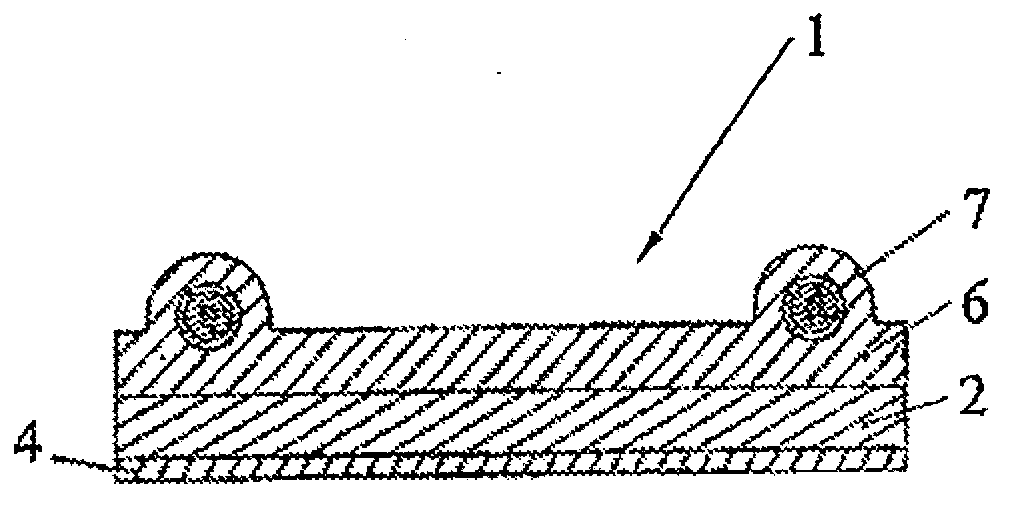Heating appliance covered with a self-cleaning coating and production method thereof
A technology for self-cleaning coatings and household appliances, applied in heating methods, coatings, household stoves, etc., can solve the problems of increased coating costs and heating household appliances, and achieve excellent adhesion and excellent catalytic activity Effect
- Summary
- Abstract
- Description
- Claims
- Application Information
AI Technical Summary
Problems solved by technology
Method used
Image
Examples
example 1
[0132] PdO / CeO on enamel media according to the invention 2 First example of double coating
[0133] The clean soleplate of the iron is made of enamelled aluminium, resting on a thick medium made of aluminum and used as a heat source to limit temperature variations as much as possible.
[0134] The assembly is heated to 300°C in an oven. The base plate, together with the medium, is placed under infrared radiation for a few seconds until the surface temperature reaches between 300°C and 350°C.
[0135] Dissolve cerium nitrate in water. The aqueous cerium nitrate solution was then sprayed onto the base plate using an air gun. Next, a layer is deposited having a thickness of approximately 50 nm to 100 nm measured according to the RBS method described above.
[0136] After applying the inner layer, the soleplate is heated in an oven to 250°C and then placed under infrared radiation for a few seconds at a temperature between 280°C and 350°C.
[0137]Spray the nitric acid-stabi...
example 2
[0144] PdO / Y on enamel media according to the invention 2 o 3 Second example of double coating
[0145] The clean soleplate of the iron is made of enamelled aluminium, resting on a thick medium made of aluminum and used as a heat source to limit temperature variations as much as possible. The assembly is heated to 300°C in an oven. The base plate, together with the medium, is placed under infrared radiation for a few seconds until the surface temperature reaches between 300°C and 350°C.
[0146] Yttrium nitrate is dissolved in water. The aqueous yttrium nitrate solution was then sprayed onto the base plate using an air gun. Next, a layer is deposited having a thickness of approximately 50 nm to 100 nm measured according to the RBS method described above.
[0147] After applying the inner layer, the soleplate is heated in an oven to 250°C and then placed under infrared radiation for a few seconds at a temperature between 280°C and 350°C.
[0148] Spray the nitric acid-sta...
example 3
[0155] (PdO+Y on the enamel medium according to the invention 2 o 3 ) Example of a single layer coating
[0156] The clean soleplate of the iron is made of enamelled aluminium, resting on a thick medium made of aluminum and used as a heat source to limit temperature variations as much as possible.
[0157] The assembly is heated to 250°C in an oven. The base plate, together with the medium, is placed under infrared radiation for a few seconds until the surface temperature reaches between 280°C and 350°C.
[0158] Yttrium nitrate was added as a dopant to a hydrated palladium nitrate solution stabilized with nitric acid and sprayed onto the substrate using an air gun. A layer is then deposited having a thickness measuring approximately 50 nm to 100 nm according to the RBS method described above.
[0159] After applying the outer layers, the assembly was rebaked at 500° C. for four minutes under infrared radiation.
[0160] An iron soleplate is obtained, the self-cleaning co...
PUM
| Property | Measurement | Unit |
|---|---|---|
| thickness | aaaaa | aaaaa |
Abstract
Description
Claims
Application Information
 Login to View More
Login to View More - R&D Engineer
- R&D Manager
- IP Professional
- Industry Leading Data Capabilities
- Powerful AI technology
- Patent DNA Extraction
Browse by: Latest US Patents, China's latest patents, Technical Efficacy Thesaurus, Application Domain, Technology Topic, Popular Technical Reports.
© 2024 PatSnap. All rights reserved.Legal|Privacy policy|Modern Slavery Act Transparency Statement|Sitemap|About US| Contact US: help@patsnap.com










